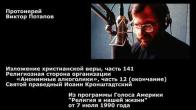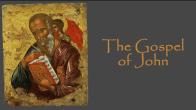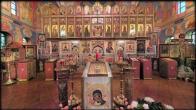You are here
New Hieromartyr Constantine Golubev
January 23/February 5, September 19/October 2 and 7/20 November (uncovering of relics)
 The Russian Church of the 20th Century has witnessed a countless host of martyrs, many of them recently glorified either as Saints of All-Russia, or as locally venerated Saints. One of the first to take his place among the multitude of witnesses to the Truth was the renowned missionary to the Bogorodsk area, Archpriest Constantine Golubev (1852 - 1918.), who through the podvig of martyrdom struggle glorified the Lord.
The Russian Church of the 20th Century has witnessed a countless host of martyrs, many of them recently glorified either as Saints of All-Russia, or as locally venerated Saints. One of the first to take his place among the multitude of witnesses to the Truth was the renowned missionary to the Bogorodsk area, Archpriest Constantine Golubev (1852 - 1918.), who through the podvig of martyrdom struggle glorified the Lord.
Fr. Constantine was born in 1852, into the family of a church reader, in the village of Baranovka, Volsky District, Saratov Province. His father reposed in the Lord when the boy was nine years of age. Soon after his father’s death, Constantine enrolled in the Saratov Theological Seminary; he graduated at the top of his class.
At the age of 24, he felt called to missionary service. With the blessing of the Most Reverend Tikhon, Bishop of Saratov and Tsarytsin, he was assigned to work in the village of Baranovka as a missionary of the Brotherhood of the Holy Cross. Three years later, recognizing Constantine Golubev’s success in the missionary field, Bishop Tikhon granted a request to assign him as anti-sectarian and anti-schismatic missionary for the Saratov Diocese.
The Saratov Diocesan Missionary’s work drew the attention of Metropolitan Sergius (Liapidevsky) of Moscow and Kolomna, who was troubled by the extent of sectarian activity in the Moscow Province, especially in Bogorodsky District.
On March 12, 1895 Bishop Tikhon (Nikanorov) of Mozhaisk ordained him to the priesthood. One month later, Fr. Constantine was assigned to be missionary in the town of Bogorodsk and for its District, and was made dean of two deaneries – that of the town of Bogorodsk, and that of Pavloposad. Fr. Constantine very quickly joined battle with the mindset not only of the Orthodox Faithful, but of the Old Ritualists.
Fr. Constantine played an active role in charitable activities to benefit the incarcerated, and was made the Prisons Committee District Division Director, and conducted Divine Services in the prison church until a priest was assigned to staff that church.
Fr. Constantine accorded a great deal of attention to problems of religious education and enlightenment of women. He used to say that Russia’s citizens would be a reflection of the kind of women there would be in the land, a reflection of the women’s level of faith and religious education. He also accorded a great deal of attention to the battle against alcoholism, and was a member of the Bogorosdsk Temperance Committee.
Amid all of his wide-ranging endeavors, Fr. Constantine would find time to devote to his own large and friendly family. His children – of whom there were seven – were strictly raised in an Orthodox spirit.
Fr. Constantine was arrested after a Vigil Service in November 1918. For several days, batiushka was under arrest in the Bogorodsk jail. Then without a trial or legal proceeding, he was condemned to death. Apparently, he was told that he was to be executed, for he managed to hand over his pectoral Cross and service book so that they might be removed from the jail. The priest did not ask to be released; he knew that he had been condemned to death, and was prepared to die. The one thing that he did not know was that, having come to know the priest’s strength of faith during his time in jail, the malefactors had chosen to inflict a painful death upon him.
We do not know the date of Fr. Constantine’s death; we only know that it was during inclement weather, with a howling wind. We know details of his execution from a speech by V.P. Shein, a member of the All-Russian Local Council of 1917 - 1918, who was later the Russian New Martyr Archimandrite Sergius, in 1922 executed by firing squad along with Metropolitan Benjamin of Petrograd and Gdov. He reported, “The firing squad executing Archpriest Constantine Golubev in Bogorodsk only wounded him; they threw him, still alive, into the pit, and began to cover him with earth. The unfortunate one would raise his head out of the pit and implore them to finish him off; his crying daughter knelt, likewise imploring them not to bury her father alive. However, it was no use, and their villainous deed was carried out to the end…”
It was known ahead of time that the priest was to be executed. Archpriest Constantine had served for 23 years in Bogorodsk, and during that time had become the spiritual father of its Orthodox residents. When a detachment of Red Guards brought the priest out of the prison and escorted him to the place of execution, an enormous crowd of people followed. Those who walked close to him heard Fr. Constantine, remembering the Savior’s words, say, “They know not what they do.”
They shot him at the edge of a pine forest, and buried him, half dead, in a shallow gully. According to eyewitness accounts, the ground covering him still “breathed” for some time. Later, people who came to the place of Fr. Constantine’s execution covered up his feet and the hem of his riassa, which were protruding from the ground.
Executed with Fr. Constantine was a certain woman who fearlessly attempted to protect him by shielding him with her body, and a young member of the Red Army who had refused to carry out the death sentence. Local residents say that as a child, he had been baptized by Fr. Constantine. Their bodies were cast into the same pit.
According to the murdered priest’s oldest daughter, Maria Constantinovna, a certain Bedov carried out the [death] sentence.
Apparently, the murderer was tortured by pangs of conscience. Several times, the deceased Fr. Constantine appeared to him. Once, upon seeing his wife come into the house with her hair unkempt, Bedov suffered a momentary delusion and took her for the murdered archpriest; he shot her to death, and then shot himself.
For decades, the pious residents of Bogorodsk venerated the place of Fr. Constantine’s death as a holy site, and although the atheists repeatedly leveled the little burial mound in efforts to wipe out all signs of the martyr’s burial, Fr. Constantine’s spiritual children and others who revered him would repeatedly restore it, would bring flowers, icons, and candles to the grave, would light a vigil lamp, and would serve memorial Panikhidas.
Thus, the memory of the accomplished missionary and martyr has come down to our days, when the Lord revealed in the fullness of His power the glory of His witness: On November 20, Archpriest Constantine’s incorrupt relics were discovered, along with the relics of the two others who had been martyred with him.
PARISH LIFE
RECENT VIDEOS
Address of our Cathedral
Subscribe to our mailing list
While all the materials on this site are copyrighted, you may use them freely as long as you treat them
with respect and provide attribution on the Russian Orthodox Cathedral of St.John the Baptist of Washington DC.









